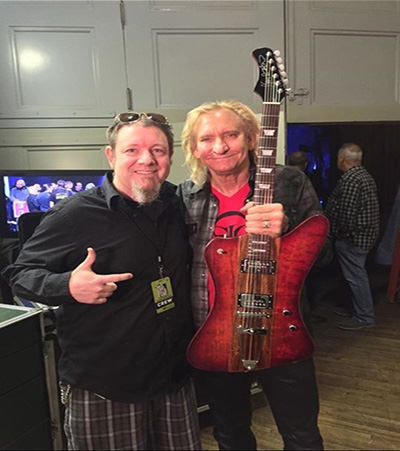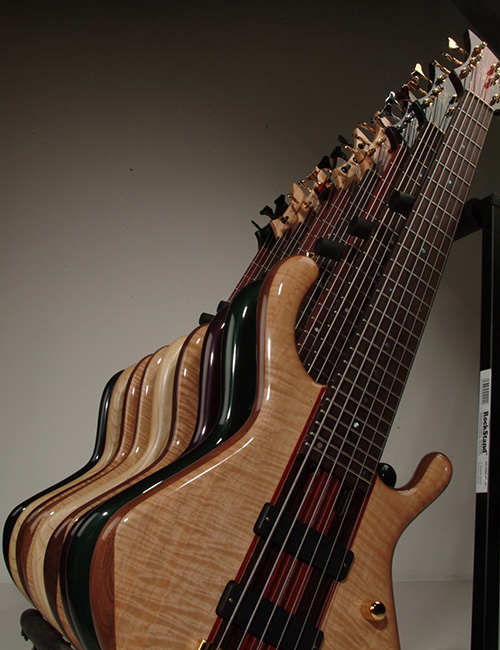Our September Guitar of The Month winner is Jon Hill!
You're in for a treat this month. Jon explains how he paints
his guitars and why he refuses to use anything but lacquer on his
builds.

"I started building guitars back in high school around 1984.
When I finished up with a guitar to a point where it was ready to
paint, I took it to my buddy's shop where they painted all types of
furniture and display stuff. Besides the fact that it looked like a
lot of fun, it showed me for the 1st time what a professional paint
booth/spray gun set up really looked like. I got tremendous insight
as to how it all works together, from the compressor, how to clean
the guns, lighting, sanding between coats, and so on. So, after
high school I meandered for a few years going to an electronics
tech school and working some sales jobs. Ultimately, I decided to
get back into guitar building full time in 1989.

At this time, I had friends that were into automotive type
paints, using an acrylic eurathane. Being naive, I thought that
this was the way to go. However, painting wood is a world away from
painting a metal door panel. First off, these types of paints are
specifically design for temp extremes and to be somewhat conforming
to dents and dings so the paint won't crack. This is the exact
opposite of what you want on a guitar. Lacquer dries much harder
enhancing the resonant qualities of the instrument.

Then in the early 90's, polyester finishes started to hit the
guitar market. Despite being 5 times the cost, it was incredible.
You can seal and fill the grain of the wood in 1 coat! We
would sand the sealer with D/A sanders the next day and prep and
ready it for color and a top coat. Truly incredible. But, polyester
finishes are thick and heavy, adding a considerable amount of
weight. Buffing them out was extreme and not for the feint of
heart. It would take me a day and a half to buff out one bass, and
like eurathane, it's very unforgiving if you burn through it. It's
almost impossible to touch up and I always had adhesion
problems.

Somewhere around 2005 or so, somebody showed me a gold top gloss
and it looked incredible. This was not a major brand of course,
because sadly those major brands never really did lacquer any true
justice, at least what was in the stores. A lot of wood grain, not
sanded properly, binding detail, they were an advocate for modern
finishes in a way. But then I saw this guitar someone else painted
with lacquer, obviously done right, and I thought full circle, time
to go back to lacquer.

Finally, the point being, its not just that I use lacquer, its
why I don't use anything else. Lacquer has every advantage. No
adhesion problems, easily repairable if a small burn or ding
happens, no mixing of volatile products, you can easily mix pigment
and liquid dyes, powdered metallics, and pearls to makeup your own
colors, it doesn't ruin your guns, and ultimately, it dries rock
hard which is the best thing for the instrument.

I start with Stringed Instrument Lacquer and spray 2
full wet coats right out of the can using a 35 psi touch
up gun. I wait about an hour, then I will spray 2 more full wet
coats and allow the guitar to dry for at least 5 days. After 5 days
or so, I will block sand with typically 150-220 grit, just until I
start going through the wood. I even sand inside the cavities,
including the neck pocket if its a bolt on. Then 2 more full wet
coats, wait an hour, then 2 more wet coats, and let it dry for
5 more days. After 5 days, I sand and repeat until grain is
filled.

For the color coat, I use the same clear and mix in the proper amount of
pigment or colored dyes. I use powdered pearls and metallics that
mix into the exact same clear. For the airbrush, I use lacquer thinner mixed with 10% clear and a few
drops of liquid dye. Once your satisfied with the
color, same process as before, 2 full wet coats followed by 2 more
full wet coats, wait 5 days then sand with 320/400 grit sandpaper
and repeat for 1 last round of clear and that should be
enough."

Thanks for sharing this with us Jon! If you have any questions
about the guitar, our products, or anything touch up related, feel
free to reach out. You can share your thoughts with us on Facebook, Twitter, or Instagram!
Stay tuned for the next blog post - there's something new every
Friday!